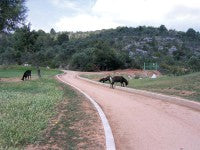Sustainability is the key
There has been plenty in the news recently about climate change and the affects global warming is having on the planet and, in particular, the Polar ice caps.
 There are calls for everyone to do their bit to help the environment and do all they can to reduce their carbon footprint.
There are calls for everyone to do their bit to help the environment and do all they can to reduce their carbon footprint.
The golf industry is no different, we are always looking at ways to make golf greener but without compromising the qualities we love about the sport, like the lush green grass and rolling fairways.
Sustainability has become a very fashionable word in the golf course design and construction business, but there are very few people around who actually implement the correct procedures to ensure the long-term viability and growth for each of their projects.
The best way to describe what sustainability means is summed up in the Brundtland Report published in 1987, which defined sustainable development as: "Meeting the needs of the present generation without compromising the ability of future generations to meet their needs."
Sustainability is extremely important in the current climes, and the golf design industry is continually learning and implementing new ways to make courses more self-sufficient and environmentally friendly.
Technology has obviously helped a lot in keeping golf greener. For example the latest irrigation systems can really help with saving or recycling water to ensure less waste.
But a lot of the best practices to keep things sustainable come from experience. A lot of the methods we use have come from our forty years experience in different methods and design. It's about knowing what works and what doesn't, plus keeping up to date with the latest research.
 When planning a golf course it is critical to design with the land. When laying out the golf course it is vital to make a number of visits and walk round the area planned for the course, feel the land and the contours. Course designers don't just sit in their office and draw.
When planning a golf course it is critical to design with the land. When laying out the golf course it is vital to make a number of visits and walk round the area planned for the course, feel the land and the contours. Course designers don't just sit in their office and draw.
Courses are laid out to follow the natural shape of the land, and in a manner to keep the earthworks to a bare minimum. By barely disturbing the land, and using the minimal amount of heavy machinery, which use a lot of energy and cause pollution, we can reduce the amount of traffic movement on site.
A prime example of following the natural outlines of the earth is our development in New Giza, Egypt. The land we are using is a former quarry but, instead of filling in parts and designing a whole new layout, we have embraced the landscape and are using the natural contours of the land to meander through the base of the quarry, bringing spectacular results.
Working in these hot climates like Egypt and other up-and-coming golfing markets like the Middle East, water consumption is a major issue.
Reducing water consumption is critical to sustainability because, if course designers and constructors don't use the absolute precise amount of water, golf as a business and sport is going to die. It is especially important in regions where water is limited, it is essential you keep a close eye on the amount of water used, and that starts from day one of the design process.
Modern irrigation systems are getting better and helping to reduce the water consumption, but intelligent design also helps. Like not using excessive amounts of turf grass in spaces that don't need grassing, and making lakes deeper, reducing their surface area to combat evaporation.
 Designers are always looking for ways to mould their course into the local culture, making it unique to the region and enhancing the indigenous area.
Designers are always looking for ways to mould their course into the local culture, making it unique to the region and enhancing the indigenous area.
For example, in places like Indonesia land acquired for golf courses have included paddy fields, which are vital for the local culture and economy.
Architects are looking to enhance the area from the moment they walk onto the planned course. So, rather than ignoring the paddy fields, they are incorporated into designs so they can continue to be used by the local people. Rather than come in and destroy the environment, the designers have actually enhanced it.
There is still plenty to do to help ease the fears of global warming, but the golf industry is certainly doing its best to play a part in making the world a greener place. And, if we can all draw up a sustainability statement and stick to what we say, then golf will continue to grow for centuries to come.
Tim Lobb is a partner of Thomson Perrett & Lobb based in London, working with five-times British Open Champion Peter Thomson and leading Australian architect Ross Perrett. For more information, visit www.tpl.eu.com
